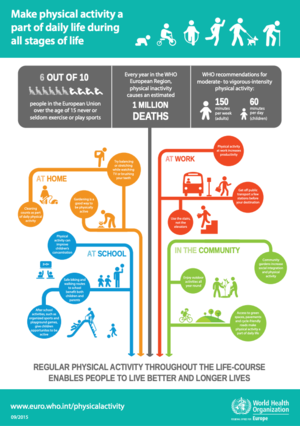Definitions
Physical activity (PA) is defined as any bodily movement produced by skeletal muscles that requires energy expenditure[1]. Physical activity includes exercise as well as other activities which involve bodily movement and are done as part of playing, working, active transportation, house chores and recreational activities.
Exercise, is a subcategory of physical activity that is planned, structured, repetitive, and purposeful in the sense that the improvement or maintenance of one or more components of physical fitness is the objective[2]
Physical inactivity (PI) is described as doing no or very little physical activity at work, at home, for transport or during discretionary time and not reaching physical activity guidelines deemed necessary to benefit public health (Bull et al 2004)[3].
Sedentary behaviour refers to any waking activity characterised by an energy expenditure ≤ 1.5 metabolic equivalents and a sitting or reclining posture. In general this means that any time a person is sitting or lying down, they are engaging in sedentary behaviour. Common sedentary behaviours include TV viewing, video game playing, computer use (collective termed “screen time”), driving automobiles, and reading[4].
Physical activity as a public health priority
Physical inactivity has a major health effect worldwide[5]. It has been identified as the fourth leading risk factor for global mortality causing an estimated 3.2 million deaths globally[1]. Of the deaths attributable to physical inactivity, 2.6 million are in low- and middle-income countries (LMICs). While physical inactivity is more prevalent in high- and middle-income countries, even in low-income countries it is among the top ten risk factors contributing to death.
Key facts on physical activity from The World Health Organisation (WHO, 2015)
- Insufficient physical activity is 1 of the 10 leading risk factors for death worldwide.
- Insufficient physical activity is a key risk factor for noncommunicable diseases (NCDs) such as cardiovascular diseases, cancer and diabetes.
- Physical activity has significant health benefits and contributes to prevent NCDs.
- Globally, 1 in 4 adults is not active enough.
- More than 80% of the world’s adolescent population is insufficiently physically active.
- Policies to address insufficient physical activity are operational in 56% of WHO Member States.
- WHO Member States have agreed to reduce insufficient physical activity by 10% by 2025[6].
Benefits of Physical Activity
The benefits of physical activity are far reaching and cover both prevention and management of long term conditions. The British Heart Foundation[7] has published a document that summarises the research that supports the use of physical activity to:
- prevent ill health and reduce the number of people dying prematurely
- enhance mental health, quality of life and self-reported wellbeing
- delay the need for care in older adults (age 65+)
- reduce health inequalities and improve wider factors influencing health and wellbeing
Physical activity helps prevent many major non-communicable diseases (NCDs). Children and adolescents who are physically active have a better chance of being healthy adults. Along with other common risk factors like hypertension, tobacco use and unhealthy diet, physical inactivity is an important factor in the rise of NCDs, which now kill more people around the world than all other causes combined. Physical activity also improves concentration, self-esteem and school performance[8].
Global Strategy
Recognising the unique opportunity that exists to formulate and implement an effective strategy for substantially reduce deaths and disease burden worldwide by improving diet and promoting physical activity, WHO has adopted, in May 2004, the “[9] which included 9 Global targets to continue to try and tackle the NCD problem; within this document this included the 25×25 target. Here are the other targets:
- A 25% relative reduction in the overall mortality from cardiovascular diseases, cancer, diabetes, or chronic respiratory diseases
- At least 10% relative reduction in the harmful use of alcohol, as appropriate, within the national context
- A 10% relative reduction in prevalence of insufficient physical activity
- A 30% relative reduction in mean population intake of salt/sodium
- A 30% relative reduction in prevalence of current tobacco use
- A 25% relative reduction in the prevalence of raised blood pressure or contain the prevalence of raised blood pressure, according to national circumstances
- Halt the rise in diabetes and obesity
- At least 50% of eligible people receive drug therapy and counselling (including glycaemic control) to prevent heart attacks and strokes
- An 80% availability of the affordable basic technologies and essential medicines, including generics, required to treat major noncommunicable diseases in both public and private facilities
In 2018 the WHO launched a new Physical Activity Guidelines (PAGs)
WHO developed the “[10] with the overall aim of providing national and regional level policy makers with guidance on the dose-response relationship between the frequency, duration, intensity, type and total amount of physical activity needed for the prevention of NCDs.
WHO Europe also recommends that regular physical activity, throughout the life course, enables people to live better and longer lives. This Physiotherapy and Physical Activity
Physiotherapists have always had a close relationship with exercise, the profession was founded on the work of remedial gymnasts and the profession has a rich history of prescribing rehabilitative exercise. Despite this, literature on physiotherapy as promoters of physical activity, is scant.
The global physical inactivity crisis, and the epidemic of life-style related diseases (non-communicable diseases or NCDs) has created an urgent need to build on our rich history of prescribing exercise and develop our approaches for prescribing PA. Creating a more active population requires joined up thinking and action from many stakeholders; physiotherapists need to be active in engaging with individuals and communities.
Physiotherapists have a lot to offer: access to people living with long term conditions, repeat consultations, exercise facilities, credibility with patients, injury or illness often creates “teachable moments”, expert knowledge, and behaviour change skills to name a few.
In the UK, all health care professionals are enabled to provide physical activity brief interventions within Resources
Related Physiopedia Pages
References
Ola!
Como podemos ajudar?


